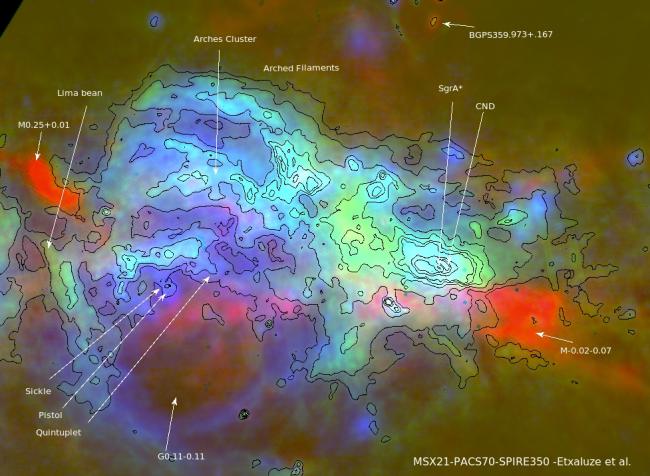
A false-color composite image of the central 50 light-years of the Milky Way as seen for the first time in the entirely of the far infrared. Many of the previously-known structures in the region are labeled; the location of the black hole is labeled "SagA*," and the inner donut as "CND." Colder material is shown in red; warmer (but still relatively cold) in blue.
The center of our Milky Way galaxy is about 27,000 light-years away in the direction of the constellation of Sagittarius. At the very center of the galaxy lies a black hole whose mass is about four million solar masses. Around it is a donut-shaped structure about eight light-years across that rings the inner volume of neutral gas and an estimated thousands of individual stars. Around that, stretching out to 700 light-years, is a dense molecular zone of activity, unique to the galaxy, with massive star forming clusters of luminous stars, giant molecular clouds, and many more, poorly understood regions as well.
There is so much obscuring dust between us and this region that visible light is extinguished by factors of over a trillion. Infrared, radio and some X-ray radiation, however, can penetrate the veil, and they have allowed astronomers to develop the picture just outlined. One span of the spectrum of particular interest to astronomers is the four octaves of infrared light from the short infrared band (just adjacent to the visible) to the submillimeter. It is precisely in this span that a large fraction of the universe emits most of its radiation – the reason being that ubiquitous, cool dust absorbs starlight (and many other kinds of radiation) from sources and re-radiates it here, in this far-infrared band. The Herschel Space Telescope, launched last year, is a facility able to detect this light.
CfA astronomers Mireya Extaluze, Howard Smith, Volker Tolls, Tony Stark, and Eduardo Gonzalez-Alfonso have used newly archived data from Herschel surveys of the region to publish the first complete far-infrared picture of the inner galaxy. The images reveal arcs, star clusters, and clumps of material, most of them previously known from radio observations, but all now seen in emission in the light of the cool dust they contain. The astronomers model the dust emission, and find that previous observations had been unable to sense a cold but massive component whose temperature is only about 23 degrees above absolute zero. The team also finds that the character of the dust emission varies across the region, and that the total radiant output of the inner donut region alone is two million solar-luminosities. These results mark the beginning, not the end, of a detailed analysis of the various cool, dusty structures found near our galaxy's core.